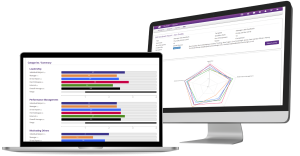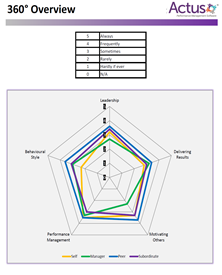Get in touch with us today!
If you have any questions, enquiries or just want to say how much you like us (or what we can do better), please drop us a line.
Effective 360-degree feedback is tremendously powerful and can be especially valuable when people are working remotely. This reduced interaction can affect how we are perceived or how our behaviours or performance is perceived by others. Using 360-degree feedback in these circumstances can be a really valuable tool to address any issues as well as supporting individual development.
If you are going to invest in 360-degree feedback it should ideally be supported by professional feedback or coaching. This will ensure that the recipients get full value out of the investment and the feedback is interpreted constructively. It can cause untold damage, just issuing feedback reports to people without support. Of course, this means that the investment required to roll out 360 feedback is significantly more than that of just generating the reports, however the value is also potentially magnified.

So, how can you achieve this if you don’t have unlimited funds or access to external coaches? Well I have had a lot of success with a train the trainer approach; the key is selecting internal colleagues with the right disposition and aptitude for internal coaching and development. It is important to have a bank of these individuals, to ensure that you are able to pair a neutral internal coach up with the feedback recipient. I wouldn’t recommend line managers taking on this role for their own direct reports as they will usually have contributed to the feedback and are going to be biased.
Structuring the 360 feedback session well is incredibly important, so if you have a number of feedback givers or coaches supporting your 360 project, it is important to ensure that they all take a consistent approach. I would recommend allowing at least 45-90 minutes for a 360 feedback session depending on complexity. I have a standard set of key positioning points that I use to set every 360 degree feedback session up for success and I would suggest training all your feedback givers in this approach. By running through these points up front it means that you can ensure that feedback is received constructively and protect the recipient from any emotional fallout if the feedback is disappointing in some way. Hopefully you will find the following structure helpful for consistency.
Start the feedback session by positioning your role as ‘coach and feedback’ giver to establish trust. If you are external to the organisation or work in a learning role it is probably easier for you to be seen as neutral. However, if you are an HR professional or line manager from within the organisation people may be a little more suspicious or nervous about opening up to you.
Start by positioning your role as ‘coach’ for the purpose of this 360 degree feedback session and explain. Assuming it is true, explain the fact that the feedback is for their eyes only. I tend to recommend that the individual may choose to share their report with their line manager after the session, but emphasise that it is their choice, not mine. If the reality is different in your organisation, make sure you explain who will have access to the feedback and why.
These questions are really useful to get a sense of where this person’s head is in relation to the feedback. If they say they are feeling really confident, excited or nervous, this gives you a useful indication of their self-confidence levels and you can position the session accordingly. Clearly, it is helpful if you have had a quick look at the individual’s report and understand whether it is generally positive or whether there might be some difficult messages to digest.
Depending on your assessment of the tone of feedback and the individual’s receptiveness to the feedback will allow you to decide whether to manage expectations or challenge more robustly. So, someone who is nervous about receiving honest feedback may have just gone out to a small number of people they know well or may have only invited some of their direct reports rather than all of them. This is going to provide less balanced feedback than someone who has thought carefully and invited a wide selection of feedback givers, including some they think they have a more difficult relationship with.

This is particularly important if you know that there is some challenging feedback within the report. It is one of the main reasons that I advocate so strongly for personalised one to one feedback rather than just sending reports out. Having investigated the relationship with each feedback giver previously, you can explore what kind of feedback they are expecting and be prepared to manage expectations, if needed.
Perhaps you have noticed that the line manager has scored lower than others. If so it may be helpful to explore their relationship with their manager up front. You may find that they are a new manager and don’t know them so well or they have a difficult relationship. If this is the case you can prepare them for the fact that this may be reflected in the feedback. You might say something like “So your manager hasn’t had a lot of time to see you demonstrate all the behaviours yet/get to know you fully?”
I always explain that feedback is incredibly helpful, but ultimately it reflects the perceptions of others rather than reality. I state that the feedback should be respected and valued, but it is down to the individual to decide whether it is helpful. They can choose the extent it needs to be taken on board or acted upon. As the coach, it is your role to ensure that the feedback is helpful and not damaging. You may challenge the individual if they are dismissing key points or support them if they are taking it too personally.
Emphasise the reality that some people are naturally high or low markers – just like teachers at school. Explain that it is more important to look for trends than absolute scores. This is particularly important with scores from individually identifiable raters like the line manager. Explain the risk of recency bias where feedback can be distorted positively or negatively by a recent experience. If they just had a blazing row with somebody for example, and then asked them to complete their feedback it is likely to be less positive than it would otherwise have been.
Finally, end on the fact that while the feedback is merely a reflection of how our behaviours are interpreted by others, this doesn’t mean that it’s not incredibly valuable. This is because we can choose to change our behaviour or stay the same should we wish. Feedback provides us with self-awareness and choices for the future.

Having set the scene, explain how you will go through the report. I generally find that starting with a high-level overview such as a spidergraph or summary is helpful. You can see an example of a spidergraph from our Actus 360 NOW tool to the right. Overall, emphasise that the purpose is to look for themes rather than anomalies. Explain that it is just as important to look for strengths as well as development areas. It is also important not to get hung up on who might have said certain statements and focus on the overall messages.
Explain that you will finish the session by identifying a couple of key strengths and how you can utilise them more and also a couple of development sessions. I like to recommend that, following the feedback it is good practice to thank the feedback givers for taking the time to provide feedback and to discuss any strengths, development areas or discrepancies with your line manager.
The key here is to get a general overview and then drill into any gaps. Use open questions to gauge how the individual is feeling. Read their non-verbal cues to determine how and when to explore things further. Remember that your role is to ensure that the feedback is helpful and insightful and never damaging. Be prepared to challenge if clear messages are being ignored but also support if certain perspectives appear isolated and/or unhelpful. Coaching experience and skills are invaluable at this stage.
Close the session by agreeing on the strengths and development areas and how these will be acted on. Discuss next steps in terms of sharing the 360 with others.
In conclusion, 360-degree feedback is a hugely powerful development tool. However it needs careful management and a commitment to proper feedback and support to maximise value. Generating a 360 report is only a small part of the process. Providing a report directly to the individual without coaching support risks, even well-meaning feedback being damaging. This can create long term ramifications for the individual and the organisation. You can use the outlined above process as a structure for consistency amongst the feedback givers in your organisation. If you want more hands on support we offer 360-degree feedback coaching or Train the Trainer sessions on request.
We have lots of supporting resources on 360-degree feedback. I dedicate two HR Uprising episodes to this topic. You can also download our free e-book on the topic here: ‘The Complete Guide to 360-degree Feedback’
Find out more about how Actus 360 NOW can support your organisation below:
Please complete the details to receive a 3 minute system tour direct to your inbox!
If you are looking for performance management software for 1000+ employees get in touch for a quote today.
Talk to one of our partnership specialists today.
Fill in your details below and then please check your email for a link to the 3 minute overview of Actus Software
If you have any questions, enquiries or just want to say how much you like us (or what we can do better), please drop us a line.